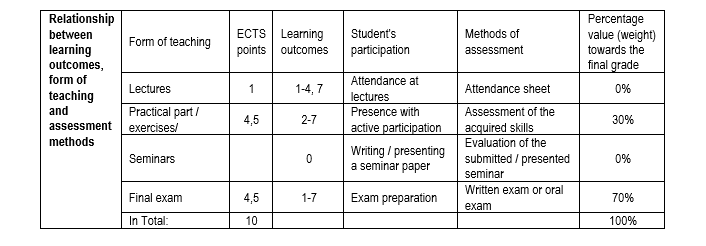By acquiring course content students will gain knowledge and skills necessary to plan and program the physical therapy process and the choice and implementation of physical therapy procedures according to the needs of clients. By mastering the course content students will acquire knowledge necessary for monitoring and learning course content of a more specific professional discipline.
Principles and procedures of implementing therapeutic exercise within the physical therapy process: activities to increase strength,movement scale,endurance,coordination,motor control and motor learning, motor development and motor safety, improvement of posture andrespiration.
Conducting activities of aerobic endurance by using ergometer, mini stair master, weights, pulleys, hydraulics, elastic bands, robotics, mechanical or electromechanical aids; increasing strength through active movement, actively assisted movement and resistance movement; stretching exercises; exercises with therapy ball; exercises in water; breathing exercises and exercises for muscles participating in breathing; breathing strategies; walk training, locomotion and balance; balance training and coordination; ergonomictraining.
Principles and procedures of implementing techniques of manual therapy including mobilisation and manipulation with the purpose to decrease pain, to increase the movement scale, to reduce or to stop swelling of soft tissue, inflammation or limitation; achieving relaxation; improving elasticity of contractible and non-contractible tissue; enhancing functions of pulmonary system.
Conducting techniques of manual therapy including therapeutic massage, massage of connective tissue, manual lymphatic drainage, acupressure massage, manual traction, mobilisation and manipulation of joints, mobilisation and manipulation of soft tissue.
Principles and procedures of implementing respiratory therapy including breathing techniques, expectoration mechanism, mobilisation and transport of secretion, drainage positions, methods of relaxation, mobilisation of thorax, respiratory training and inhalation.
Principles and procedures of implementing functional training of self-care and care of the household into the physical therapy process including activities of everyday life and instrumental activities of everyday life. Principles and procedures of implementing aids, orthoses, adaptive, protective, assistive devices and equipment.
Obavezna literatura:
- Grozdek G, i sur. Temelji medicinske masaže. Zagreb: Hrvatska udruga fizioterapeuta; 1998.
- Jakuš L, i sur. Terapijske vježbe – nastavni tekstovi. Zagreb: Visoka zdravstvena škola; 2004.
- Jakuš L, i sur. Principi i postupci primjene manipulativne terapije – nastavni tekstovi. Zagreb: Visoka zdravstvena škola; 2004.
Dopunska literatura:
- Gormley J, Hussey J. Exercise Therapy in Prevention and Treatment of Disease. Hoboken, New Jersey, SAD: Blackwell Science Ltd.; 2004.
- Hollis M, Fletcher-Cook P. Practical Exercise Therapy. Hoboken, New Jersey, SAD: Blackwell Science Ltd.; 1999.
- Bates A, Hanson N. Aquatic Exercise Therapy. Philadelphia, SAD: SAunders/Elsevier; 1996.
- Makofsky HW. Spinal Manual Therapy: An Introduction to Soft Tissue Mobilization, Spinal Manipulation, Therapeutics and Home Exercise. Thorofare, New Jersey, SAD: Slack Incorporated; 2003.
Upon completion of this course, students will be able to:
- Recommend and critically evaluate the usefulness of therapeutic exercises, manual therapy techniques, respiratory therapy, functional training and the use of aids
- Judge and critically evaluate the usefulness of the use of aids, orthoses, adaptive, protective, supportive means and equipment in the treatment process
- Select specific goals that are achieved through the application of therapeutic exercises, manual therapy techniques, respiratory therapy, functional training and the use of aids, orthoses, adaptive, protective, supportive means and equipment in the treatment process
- Evaluate the effects of therapeutic exercises, manual therapy techniques, respiratory therapy, functional training and the use of aids, orthoses, adaptive, protective, supportive means and equipment in the treatment process.
- Manage the implementation of therapeutic exercises to increase all forms of strength
- Manage the implementation of manual and respiratory therapy techniques, and functional training
- Recommend the use of aids, orthoses, adaptive, protective, supportive means and equipment in the treatment process



